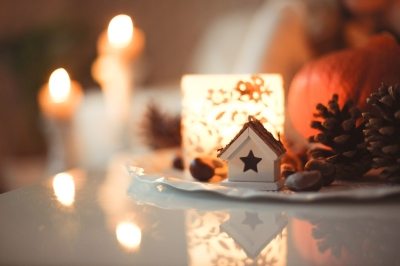“Hygge (pronounced Hoo-ga) is about an atmosphere and an experience, rather than about things. It is about being with the people we love. A feeling of home. A feeling that we are safe, that we are shielded from the world and let our guard down.” The little book of Hygge- the Danish way to live well by Meik Wiking from The Happiness Research institute, Copenhagen.
“Hygge can be tasted, heard, smelled, touched and seen. But, most importantly, hygge can be felt.” But would hygge still be possible in a cold, draughty and damp location? If the environment makes you uncomfortable your experience is likely to be un-hygge or “Uhyggelight [uh-hoogalit]”. So how do we make sure that this doesn’t happen, to help maximise hygge in your home?
#1- A cosy coat
“Hygge is the antidote to the cold weather, the rainy days and the duvet of darkness.” So, a blanket/duvet watching TV on the sofa is a must and it is the same for your house. If your house has a thick blanket over it will be more snug therefore more hygge – what could be better? Yet, you wouldn’t want to go out in mid- winter with a woolly jumper and shorts – neither does a house. To make sure you are completely cosy it would be wise to wear boots, long socks, trousers tucked in vest and socks, shirt, jumper, coat, scarf, gloves and hat. More importantly – you don’t want any gaps for the cold to get in, so layering is advised. This is the same for your house – the blanked should wrap around the whole house – from the roof to the floor to make sure there are no midriffs showing.
#2- Drafts and Fire places
Candles and fires are an integral part of Hygge but the ‘draw’ of the fire often causes drafts. To help combat this, a separate air inlet near the fire could draw cold external air straight into the fire. This reduction in draftiness could also be helped by having not just a woolly jumper but a wind proof jacket and woolly jumper? The less gaps in the wind proof jacket the less drafts. This will leave the sitting room warm and draft free whilst making sure that there is plenty of air for the fire.
#3- Fresh air
So, now we have woolly jumpers and a windproof jacket on the house but we still need air to breath. If there is a storm outside, wood burning stove, candles, hot chocolate, blankets and cosiness you aren’t likely to open the windows for fresh air- but we need to breathe, get rid of smells and remove excess moisture so what is the solution? If we just suck out the stale air this would force cold air through the woolly jumper & windproof jacket and then cause cold drafts so, the key is using the stale air to heat up the colder fresh air by using mechanical ventilation with heat recovery- thus we have controlled levels of fresh heated air, no drafts, no smells and lower energy bills. Surely this will help up the hygge factor?
#4- Windows
Light, especially candle light is an essential to hygge and diffuse natural light is also critical.
The little book of Hygge- defines a Hyggekrog [hoogacrow] as “The nook or a kitchen or living room where one can sit and have a hyggelig time”. This sounds amazing, however these areas tend to be near to windows which fell cold. The proximity to cold windows with condensation makes the cushions mouldy would also rapidly reduce the cosiness factor. But there are windows which are more insulating. Improving the quality of windows, frame and how they are installed would reduce the cold feeling, move the condensation to the outside of the window (so no mouldy cushions) and the surface of the glass will feel warm so even if you lean against the glass the hygge isn’t affected. A hygge-nook can now be created anywhere in the house – even when the rain/snow pelts down outside, even sitting on a window sill will feel warm and cosy.
#5- Sustainable materials
We have the “Hyggekrog” or hygge nook, the fire, the candles but what about things made from wood and natural materials? Wood often has a low embodied carbon and combining this with the woolly jumper and wind proof jacket is easy. Making sure that the roof extends over the walls to create an umbrella and ensuring the floor has a decent pair of wellies will help the home battle all the elements and keep the home snug and sheltered. A traditional sheep’s wool blanket, wood framed doors & windows and wooden structure will help reduce the carbon footprint whilst providing yet more hygge-elements.
These tips individually and/or in combination will help to make homes more “Hyggenhjorent [hoogajorent] – ‘in the corner of hygge”. The little book of Hygge states that “Seven out of ten Danes say they experience most hygge at home” so the home would seem an appropriate place to start maximising hygge.
All quotes are from – The little book of Hygge- the Danish Way to Live Well by Meik Wiking from The Happiness Research institute, Copenhagen. Penguin Life
We are experts in making buildings snug and comfortable, so please let us know if you would like more tips on making your home more hygge, cosy, comfortable and snug.





